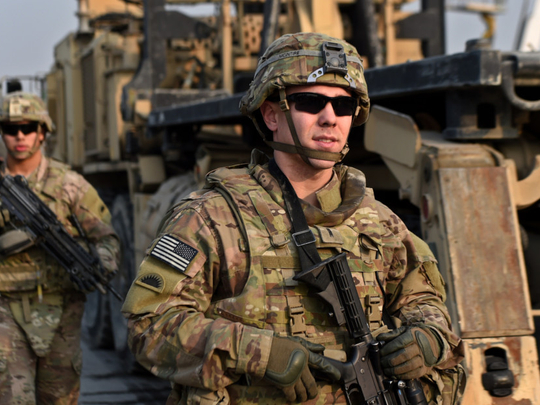
Americans have some tough choices ahead. Can they still spend wildly on costly weapons superiority over countries such as Russia and China and pay for the intelligence and armed forces required to manage threats from groups such as Al Qaida and Daesh (Islamic State of Iraq and the Levant)?
The terrorist danger is certainly more immediate. It requires an additional $70 billion (Dh257 billion) this fiscal year beyond the $585 billion for the core defence budget. The Overseas Contingency Operations account covers the fighting in Iraq, Afghanistan and Syria, as well as US special forces and intelligence gathering, plus military, economic and humanitarian aid to our allies.
Meanwhile, the prospective threats from Moscow and Beijing require growing costs in what feels like an old-school Cold War. On January 7, Sean Stackley, the Navy’s assistant secretary for research, development and acquisition, drove home this new arms race.
Stackley, a Naval Academy graduate with advanced engineering degrees from MIT, spent 26 years in the Navy. He also spent three years on the Senate Armed Services Committee staff before being nominated by the George W. Bush administration for the Navy’s top procurement job. He was confirmed in July 2008. Stackley, who reflects thinking in the Navy and other services, is someone worth listening to.
“Our superiority at sea demands that we maintain superiority in technology, science, engineering,” he said during remarks at the Atlantic Council.
He pointed out China’s “impressive” investment in naval capabilities, citing the country’s “new aircraft carrier, nuclear submarines, their fifth-generation fighter, amphibious capabilities, unmanned aircraft and anti-ship cruise and ballistic missiles”. Stackley added, “Russia, too, is revitalising its blue-water navy capabilities.” But wait.
China’s one floating aircraft carrier is a refurbished old Russian carrier bought from Ukraine in 1998. Ukraine had been using it as a museum. Really.
It has been a training ship since 2012, and on a recent sea trial it had an explosion that knocked out its new electrical system. There are reports China is building its first, non-nuclear powered carrier, said to be comparable to a conventional carrier that entered US Navy service 25 years ago.
The Defence Department reported last June that “China acknowledged publicly for the first time in 2013 its desire to build indigenous aircraft carriers”. The first “will likely be operational sometime at the beginning of the next decade,” the department said.
As for Russia, its first nuclear-powered supercarrier had its hull laid in 1988, but construction was cancelled in January 1991, when it was 20 per cent completed. The project was scrapped the next year.
The first US nuclear-powered supercarrier, the USS Enterprise (CVN 65), came into the force in 1962 and was deactivated in December 2012. Today, the US has 10 aging supercarriers in operation. But, Stackley said, “the Navy’s requirement is for 11 [new] aircraft carriers.”
The first replacement, the USS Gerald Ford (CVN78), is to be delivered next year at $12.9 billion. Construction is just starting on the USS John F. Kennedy (CVN 79), to be completed in 2020 at an estimated $11.5 billion, according to Stackley. Carriers were important in the Second World War, less so in the Cold War, and needed to a degree in the Gulf and in the conflicts in Afghanistan and Iraq and for deterrence in the Pacific.
The big hangover from the Cold War is the replacement programme for the 14 Ohio-class strategic ballistic missile submarines (SSBNs), which can carry 24 intercontinental ballistic missiles, each able to deliver up to 12 independently targeted nuclear warheads.
Thanks to a 2010 arms control treaty with Russia, beginning in 2018 only 12 Ohio-class SSBNs with 20 of their missiles loaded will be deployed at one time. Each missile will be limited to four or five warheads.
That means the US will still have more than 1,000 sub-launched warheads available, with some 320 on ready-to-fire, 24-hour alert on the four subs normally on patrol in the Atlantic and Pacific oceans. Each warhead is at least five times as powerful as the bomb that hit Nagasaki.
What’s the threat?
It’s competition with the Russians, Cold War-style. Russia’s modernisation of its smaller number of less-capable SSBNs began 15 years ago. The first of Moscow’s eight planned new Borey-class SSBNs was finished in 2013, and three more are underway.
China did not have its first strategic-missile-launching submarine deployed before 2010. The Defence Department reported last year that Beijing’s three Jin-class SSBNs (Type 094) were operational, and up to five may enter service before China proceeds to its next generation SSBN (Type 096) over the next decade.
Replacing the Ohio-class SSBNs, Stackley said, is the Navy’s “number one priority”. The current plan is for 12, with construction of the first to begin in 2021 and be completed in 2029, with deployment in 2031. Thereafter, it’s a one-for-one replacement as the older ones retire through 2040.
The new SSBNs will carry only 16 missiles but will be “fitted with the most up-to-date capabilities and stealth to ensure they are survivable throughout their full 40-year life span,” according to a Navy statement.
Over a 15-year period, the cost of this Ohio replacement programme will be “about $100 billion”, Stackley said. These days, terrorists are the first threat, and not a single one will be deterred by a nuclear warhead.
It seems wasteful to spend that kind of money re-creating a vast nuclear force that has never been used, on a scale that was likely never needed.
Fewer SSBNs would be better.
—Washington Post








